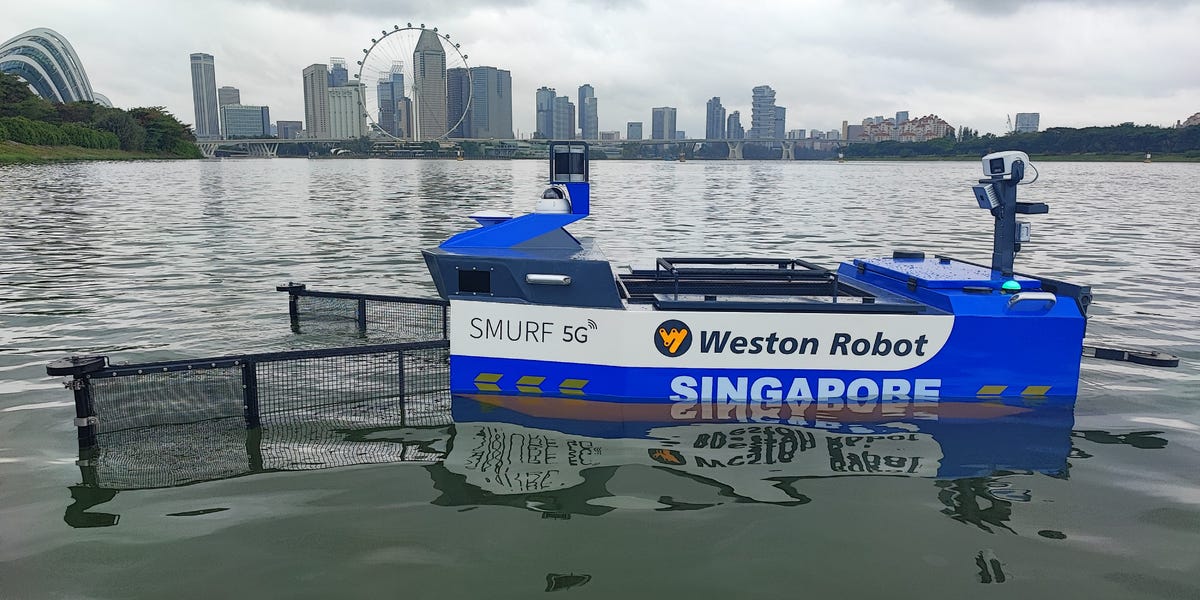- Pollution is a consistent problem in parts of the Singapore River.
- Previously, people in gas-powered boats collected garbage from the water.
- But new, unmanned 5G-powered boats are doing the same job with fewer carbon emissions.
- This article is part of “5G Playbook,” a series exploring one of our time’s most important tech innovations.
If you go to Singapore, you’ll find robots at work. The island nation has the second-highest robot density in the world. There are barista robots, construction robots, surgeon robots, and eldercare robots. And now another group of robots using 5G technology has entered the scene: river-cleaning robots.
These robots are technically called “unmanned surface vessels,” or USVs, and they’re designed to collect garbage and monitor water quality. Weston Robot, a Singaporean company that develops robotic solutions, designed and produced the robots.
These robots are currently working in a popular central area, Marina Bay. The Singapore River flows into the man-made bay, which is surrounded by city landmarks. With the number of people and businesses living and working around this area, pollution is a consistent problem that needs constant monitoring. The hope is that these gliding, garbage-collecting robots can help.
The robots are part of a larger 5G initiative
The current Marina Bay project is the result of a partnership between Weston Robot and the Infocomm Media Development Authority, or IMDA, a statutory board under Singapore’s Ministry of Communications and Information. Singapore has heavily invested in 5G technology: In 2019, the IMDA invested nearly $30 million into 5G research and innovation. Two years later, the nation set another large sum, about $21 million, aside for 5G commercialization. As of February, Singapore’s first two stand-alone 5G networks covered about 95% of the nation — the expectation is that, by 2025, there will be full coverage.
The pilot robot project kicked off in September 2022 and is expected to wrap up in the first half of 2024, Yanliang Zhang, the CEO of Weston Robot and an adjunct associate professor at the National University of Singapore, told Insider.
Zhang explained that 5G enhances the USVs’ abilities. The connection enables real-time remote control of the robots. The fifth generation of cellular wireless technology has greater upload bandwidth than earlier wireless standards, such as 4G and LTE. This increased bandwidth makes passing the information the robot’s sensors and camera feed collect to a network of servers more seamless. Zhang said that the 5G connection also enables the remote operator to receive real-time alerts and a comprehensive view of the robot during the cleaning process.
“The robots need to be connected to a 5G network in order to achieve their desired efficiencies and to operate with safety in mind,” he explained.
The 5G cleaning robots replaced gas-powered boats
Before the robots, people operating gas-fueled boats cleaned the waterways around Marina Bay. Channel NewsAsia, a TV network in Singapore, reported that these boats produced as much as 20 tonnes of carbon a year. The IMDA said the robots, which run on a battery charge, can reduce carbon emissions by about 80% compared to the boats.
While people primarily used nets to scoop trash out of the water, the robots zip around on paths toward the trash. The netted “arms” guide the trash into the vessel’s body, where it is stored.
The robots can also test the pH levels of water and are equipped with a chemical oxygen demand, or COD, sensor. COD sensors quantify the levels of oxidizable pollutants, such as sewage and industrial waste, that are in the water. Pollution can change a water’s pH and disturb the environment. Marina Bay is home to animals including otters — whose population has boomed since Singapore substantially cleaned up its waterways in the 1980s — and Asian water monitors.
For now, the robots are in the Marina Bay area, but “we intend to deploy the 5G-enabled eUSV in multiple locations, including park connectors, city canals, ponds, and reservoirs in Singapore,” Zhang said.
Read the full article here





